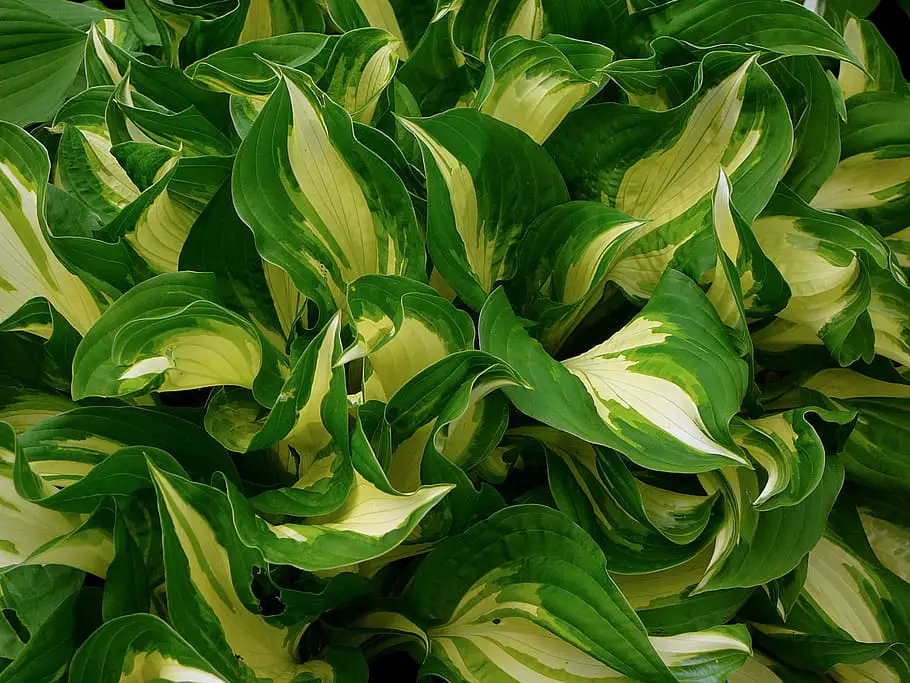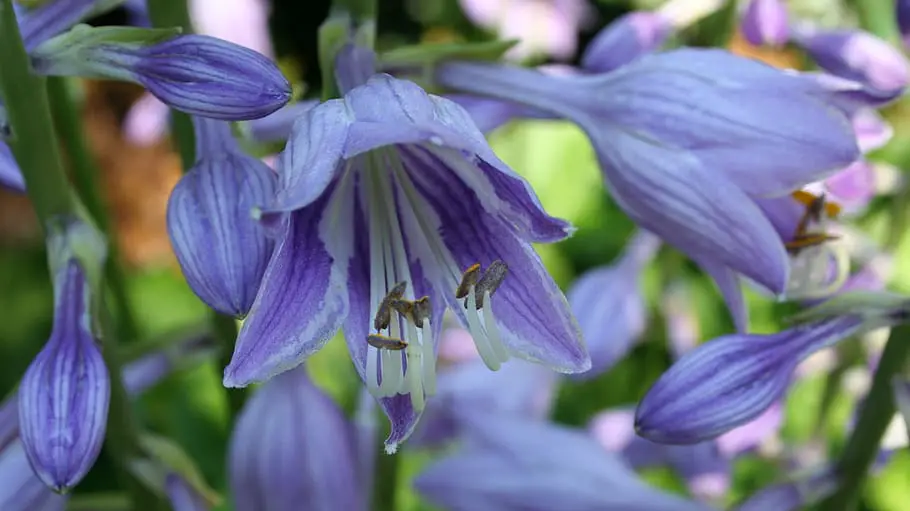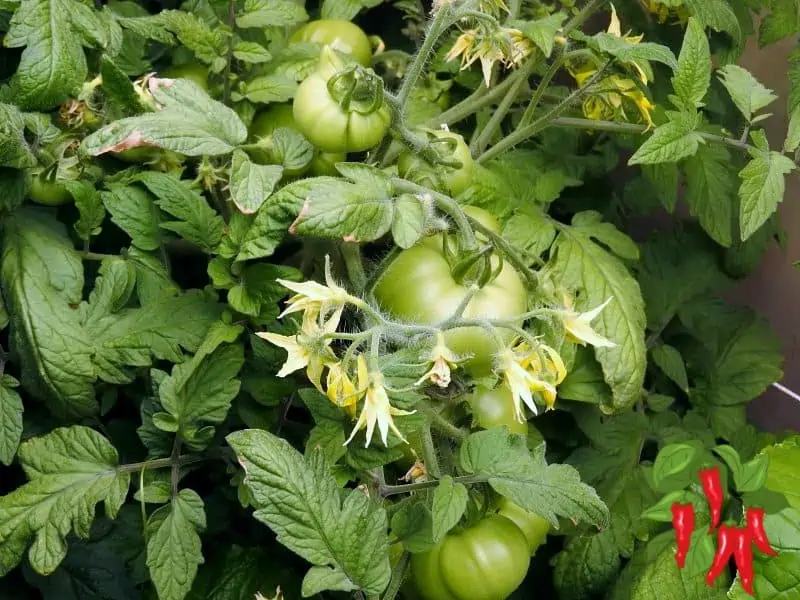This post may contain affiliate links. If you buy something from one of our links we may earn a commission. Thanks

Looking to spruce up your garden with something truly spectacular? Discover Heart Shaped Hosta Care and transform your shady spaces into vibrant retreats.
These charming perennials offer lush foliage and a heartwarming aesthetic that enchants visitors and homeowners alike. Join us as we delve into easy care tips to ensure your Hostas flourish!
Key Takeaways:
- Optimal Planting Time: Heart-shaped Hostas should ideally be planted in early spring or fall to take advantage of milder temperatures, which help the plants establish without the stress of extreme heat or cold.
- Soil and Light Requirements: Hostas thrive in well-draining, nutrient-rich soil with a slightly acidic to neutral pH. They perform best in partial to full shade, as too much sunlight can scorch their leaves, particularly the variegated and lighter colored varieties.
- Watering and Mulching: Consistent moisture is crucial for Hostas, but they should not sit in waterlogged soil. Mulching helps retain soil moisture, keeps the roots cool, and suppresses weeds, but should be kept away from the plant’s crown to prevent rot.
- Fertilization Needs: A light application of a balanced, slow-release fertilizer in early spring can promote healthy growth. Over-fertilization should be avoided to prevent damage to the plants.
- Pest and Disease Management: Slugs and snails are common pests that can be deterred with organic methods like copper barriers or diatomaceous earth. Deer and rabbits can be kept at bay with physical barriers or repellents. Monitoring for fungal diseases and maintaining good air circulation can help prevent issues.
- Dividing and Transplanting: Hostas can be divided every few years to maintain their health and manage garden space. This is best done in the spring or early fall. When transplanting, ensure the crown is at soil level and water thoroughly to establish roots.
- Edible Qualities: While primarily grown for their foliage, Hostas are also edible, with young leaves that can be used in cooking, offering flavors similar to spinach and asparagus.
- Following these guidelines, gardeners can enjoy the lush beauty and practical benefits of heart-shaped Hostas in their shade gardens, enhancing the aesthetics and biodiversity of their outdoor spaces.
An Introduction to Heart Shaped Hosta Care
A Lush Tapestry of Heart Shaped Leaves
With their unique heart-shaped leaves, these perennials are not just plants; they’re a lush tapestry of greens, blues, and golds that thrive under a canopy of trees or in that shady corner by your porch.
Ideal for softening hard lines in landscape design, heart-shaped Hostas bring a touch of romance and texture to any garden setting.
Hardy Heroes of the Plant World
Hostas are the hardy heroes of the plant world, often outliving the very hands that planted them.
Known for their robust nature, these perennials endure through cold snaps and dry spells, making them a staple in perennial gardens.
They don’t just survive; they thrive, adding splashes of color and lush texture, enhancing the beauty of your outdoor retreat without demanding much in return.
Versatile Garden Charmers
Whether nestled in a quaint container on a shady balcony or spread out in a serene border, heart-shaped Hostas are a testament to both beauty and resilience in the plant kingdom.
Their ability to adapt to various garden settings makes them especially valuable for gardeners looking to create a continuous impact throughout the growing season.
Stay Tuned for Expert Care Tips
Stay tuned as we dive deeper into how to grow, nurture, and make the most of these charming shade lovers in your garden!
Whether you’re a seasoned gardener or just starting out, learning to care for heart-shaped Hostas can make your gardening experience more rewarding.
Want To Buy Heart Shaped Hostas Online?
I bought my Hostas here on Amazon. They are mixed varieties but they are healthy bare root plants with healthy shoots and they are very affordable.
Here is my unboxing video
Getting to Know Heart-Shaped Hostas
Diverse Palette of Colors and Textures
Heart-shaped Hostas are a visual delight, known for their wide array of colors and intricate textures.
These perennials can range from vibrant greens to deep blues, and even golds, often featuring variegated patterns that add a dynamic contrast to any garden:
- Green Varieties: Rich and lush, perfect for bringing a sense of freshness to shady spots.
- Blue Varieties: These have a waxy coating that gives the leaves a stunning blue hue, adding a cool tone to the garden palette.
- Gold and Yellow Varieties: Brighten up darker areas with their cheerful shades.
- Variegated Varieties: Striped or edged in creams and whites, these Hostas add visual interest and draw the eye.
Unique Leaf Textures
The texture of heart-shaped Hostas can vary significantly, adding to their appeal:
- Smooth Leaves: Offer a sleek look, reflecting light and brightening shady garden corners.
- Ridged and Wavy Leaves: Create a robust texture that stands out, providing depth and contrast against smoother garden elements.
Versatile Uses in Garden Design
Heart-shaped Hostas are incredibly versatile, and suitable for various garden applications that enhance aesthetic appeal and functionality:
- Borders: They form dense, leafy borders along garden paths or between different sections of a garden.
- Containers: Ideal for patios or balconies, Hostas in containers can be moved to suit light conditions and design preferences.
- Ground Covers: Low-growing varieties spread out to cover large areas, suppressing weeds and maintaining soil moisture.
Companions for Other Shade-Loving Plants
Hostas are excellent companions for other shade-loving plants. Their broad leaves provide a lush backdrop that highlights the delicate forms of ferns, bleeding hearts, or astilbes:
- Ferns: The fine texture of fern leaves contrasts beautifully with the broad, heart-shaped leaves of Hostas.
- Bleeding Hearts: The arching sprays of Bleeding Heart delicate flowers pair well with the solid presence of Hostas.
- Astilbes: With their feathery blooms, astilbes add a light, airy feel to the denser hosta foliage.
By integrating heart-shaped Hostas into your garden, you can create a serene and visually appealing landscape that thrives even in the shade.
In the following sections, we’ll dive into how to plant, grow, and care for these charming plants to ensure they bring joy to your garden for years to come.
What Is A Hosta?
Hosta (/ˈhɒstə/,syn. Funkia) is a genus of plants commonly known as Hostas, plantain lilies and occasionally by the Japanese name gibōshi.
Hostas are widely cultivated as shade-tolerant foliage plants. The genus is currently placed in the family Asparagaceae, subfamily Agavoideae,[6] and is native to northeast Asia (China, Japan, Korea, and the Russian Far East).Like many “lilioid monocots”, the genus was once classified in the Liliaceae.
The genus was named by Austrian botanist Leopold Trattinnick in 1812, in honor of the Austrian botanist Nicholas Thomas Host.
In 1817, the generic name Funkia was used by German botanist Kurt Sprengel in honor of Heinrich Christian Funck, a collector of ferns and alpines; this was later used as a common name and can be found in some older literature. https://en.wikipedia.org/wiki/Hosta
Planting Your Heart Shaped Hostas
When to Plant Your Hostas
The best times to plant heart-shaped Hostas are in the spring or fall. Why? Well, the cooler temperatures and more frequent rain help these little guys settle in without stressing too much.
Planting in the spring gives them a full growing season to establish, while fall planting ensures they’re ready to burst into growth come spring.
Soil Prep and Planting Tips
Before you get those Hostas in the ground, here’s how to make sure your soil is ready to welcome them:
- Soil Quality: Hostas love rich, well-draining soil. If your dirt packs more clay or sand than ideal, just mix in some compost or peat moss to improve its texture and nutrients.
- Drainage: Make sure your planting area doesn’t hold water. Standing water can rot hosta roots. If drainage is a problem, consider raising the bed slightly or choosing a different spot.
- Digging the Right Hole: The hole for your hosta should be twice as wide as the root ball but just as deep. This gives the roots room to spread out but keeps the base of the plant (the crown) at soil level to prevent rot.
Where to Plant Them
Picking the right spot for your Hostas is crucial, not just for their health but also for how great they’ll make your garden look:
- Lighting: Heart-shaped Hostas thrive in shade to partial sun. Too much sun can scorch their leaves, so look for a place that gets some morning light but is protected during the hotter part of the day.
- Visual Impact: Use Hostas to fill in the blanks in your shade garden. They look fantastic under trees, along north-facing walls, or around the edges of paths. Their lush leaves can hide less attractive parts of garden beds, like leggy stems of other plants.
- Companion Plants: Hostas go well with other shade lovers like ferns and impatiens. The contrast between hosta leaves and finer-textured plants can really make both stand out.
With these tips in hand, you’re all set to give your heart-shaped Hostas the best start in their new home.
Get ready to watch them grow and transform your shady spots into stunning garden features!
Heart Shaped Hostas Care – Optimal Growing Conditions
Lighting Up Their World:
Heart-shaped Hostas need just the right amount of light to show off their best colors and maintain healthy growth. Here’s the scoop:
- Shade to Partial Sun: These Hostas perform best in partial to full shade. Too much sunlight can burn their leaves, especially those with lighter colors.
- Morning Sun: If they get any direct sun, make sure it’s in the morning. Afternoon sun, especially in hotter climates, can be too intense.
- Filtered Light: A spot under trees that filters the sunlight through leaves is ideal, giving your Hostas enough light without the harsh direct rays.
Soil Conditions: Just Right
Hostas aren’t too picky about soil as long as it meets a few basic needs:
- Richness: They love nutrient-rich soil. Mixing in organic matter like compost or well-rotted manure can boost the health of your Hostas.
- Drainage: Well-draining soil is crucial. They like moisture but hate soggy feet, so avoid areas where water pools.
- pH Levels: Slightly acidic to neutral pH (about 6.5 to 7) is perfect for Hostas. You can test your soil’s pH with a kit from your local garden center.
Keeping the Moisture Consistent
Hostas thrive in moist soil, but there’s a right way to manage it:
- Mulching: Apply a layer of organic mulch around your Hostas. This not only helps retain soil moisture but also keeps the roots cool and suppresses weeds.
- Watering Routine: Water your Hostas regularly, especially during dry spells. The goal is to keep the soil consistently moist but not waterlogged.
- Avoid Overhead Watering: Water at the base to avoid wetting the leaves, which can lead to fungal diseases.
With these care tips, your heart-shaped Hostas will have the optimal conditions they need to flourish.
Providing just the right amount of light, the perfect soil, and consistent moisture will help you cultivate a garden that’s both thriving and visually stunning.
Routine Care and Maintenance of Heart Shaped Hostas
Watering Wisely
Keeping your Hostas hydrated is key, but it’s all about balance:
- How Much: Water your Hostas deeply enough to moisten the soil around their roots. This usually means about an inch of water per week, whether from rainfall or your hose.
- When to Water: Early morning is best. This helps reduce evaporation and gives the leaves time to dry out, preventing fungal diseases.
- Method: Aim for the base of the plants to keep the leaves dry and prevent leaf rot.
Feeding Your Hostas
Hostas aren’t heavy feeders, but a little food can go a long way:
- Type of Fertilizer: A slow-release, balanced fertilizer works best. It feeds them gradually and keeps them growing strong.
- When to Apply: Early spring, just as the new leaves start to unfurl, is the ideal time. You might add a little more in mid-summer to support growth if your Hostas look like they need a boost.
Mulching Magic
Mulch isn’t just for looks; it has several practical benefits for your Hostas:
- Benefits: Mulch helps retain soil moisture, keeps the roots cool, and suppresses weeds.
- How Much: A layer of about 2 to 3 inches of organic mulch like shredded bark or leaf mold is perfect.
- When to Mulch: Refresh the mulch layer in the spring to prepare for the growing season and again in the fall to protect over winter.
Managing the Bloom Cycle

Hostas bloom, but their flowers aren’t usually the main attraction. Personally, I think they are quite attractive. Here’s how to handle them:
- Enjoy the Blooms: If you like the flowers, which can attract pollinators, let them bloom.
- After Bloom Care: Once the flowers fade, cut the stalks back to the base to direct energy back to the leaves, promoting lush foliage growth.
Preparing for Dormancy
As the seasons change, your Hostas need to prepare for winter:
- Signs of Dormancy: Leaves turning yellow and dying back are natural signs it’s time to get ready for winter.
- Winter Care: Once the foliage dies back, clean up any dead material to prevent disease and pests.
- In colder areas, a little extra mulch after the ground freezes can help prevent freeze-thaw cycles that may heave plants out of the ground.
Hosta Temperature and Hardiness
Hostas are versatile and can thrive in a range of climates, primarily suited for USDA Hardiness Zones 3 through 9.
They are particularly hardy, with some varieties capable of tolerating temperatures as low as -40°F and others well-suited to withstand brief periods of colder winter climates as well as the heat in warmer regions.
Bear in mind that Hostas in pots can lose 2 zones of hardiness if left unprotected. In most areas this is not a problem but if you live in a really cold area give them some protection.
Temperature Tolerance:
- Hostas generally prefer cooler weather and thrive best in temperatures between 55°F and 75°F (13°C-24°C). In regions where temperatures rise above this range, it’s crucial to provide some shade to prevent the leaves from wilting and potentially causing plant death.
- During the winter, they can withstand very low temperatures, even down to -40°F in some cases, but require protection like mulching to help insulate the roots and prevent frost heave.
Hardiness Zone Specifics:
- Zones 3-4: Certain hosta varieties like ‘Blue Angel’ and ‘Royal Standard’ are recommended as they can handle the extremely cold temperatures prevalent in these zones.
- Zones 5-9: Varieties such as ‘Sagae’, ‘Sum and Substance’, and ‘Fire Island’ are suitable as they can tolerate a wider range of temperatures, making them ideal for regions with varying climatic conditions throughout the year.
It’s important to select hosta varieties that match your specific climate conditions to ensure they thrive.
Additionally, providing adequate shade during hotter months and protective mulching during cold winters can help maintain their health and vigor.
For gardeners in particularly hot or cold climates, choosing the right variety and ensuring proper care is key to successful hosta gardening.
By following these care guidelines, your heart-shaped Hostas will thrive and beautify your garden year after year.
Proper watering, fertilizing, and winter preparations ensure that these shade-loving perennials continue to impress with their resilience and beauty.
Dividing and Transplanting Heart Shaped Hostas
Dividing and transplanting Hostas are essential practices to maintain their health and manage space in your garden.
Propagating Hostas helps rejuvenate older plants, enhance their growth, and allow you to spread the beauty of Hostas to other parts of your garden or share with friends.
Here’s how you can successfully divide and transplant your heart-shaped Hostas:
Step-by-Step Process for Dividing Hostas:
- Choose the Right Time: The best time to divide Hostas is in early spring as they emerge from the ground or in the late summer after they bloom. This timing helps minimize stress on the plants.
- Prepare the Plant: Water your Hostas thoroughly one day before dividing to ensure the roots are moist.
- Dig Up the Hosta: Carefully dig around the plant, starting a few inches away from the outer leaves. Use a garden fork or spade to lift the root ball out of the ground gently.
- Divide the Clump: Place the root ball on a tarp and use a sharp knife or spade to cut it into smaller sections. Each section should have at least two or three shoots and a portion of the root system.
- Prepare the New Location: Ensure the new planting sites are prepared before you start dividing. The sites should have well-draining soil, enriched with compost to give the transplants a good start.
Tips for Successful Transplanting:
- Handle With Care: When moving the divisions, handle the roots gently to avoid damage. Damaged roots can hinder the plant’s ability to establish in a new location.
- Plant at the Right Depth: Plant the divisions so the crown (the part where the roots meet the stems) is at soil level. Planting too deep can lead to rot, and planting too shallow can expose the roots.
- Water Generously: After transplanting, water the Hostas thoroughly to settle the soil around the roots and help eliminate any air pockets. Keep the soil consistently moist for the first few weeks to support root growth.
- Mulch the Area: Apply a layer of mulch around the new plants to retain moisture, suppress weeds, and provide insulation from temperature extremes.
- Monitor Growth: Keep an eye on your transplanted Hostas, especially during the first growing season. Ensure they receive adequate water and are not competing with weeds for nutrients.
By following these steps and tips, your heart-shaped Hostas can thrive and beautify different parts of your garden.
Dividing and transplanting helps manage the size and shape of your hosta displays and invigorates the plants, leading to more vigorous growth and increased blooms.
Dealing with Pests and Problems in Heart Shaped Hostas
Heart shaped Hostas, while robust and versatile, can encounter several pests and diseases. Here’s how you can protect these garden favorites and ensure they continue to thrive.
Combatting Slugs and Snails:
- Barriers: Create physical barriers around your Hostas using crushed eggshells, diatomaceous earth, or copper tape. These materials deter slugs and snails because they cannot cross without harming themselves.
- Organic Baits: Use organic slug baits that contain iron phosphate, which is safe for pets and wildlife but effective in controlling slug populations.
- Manual Removal: Regularly inspect your garden in the early morning or after rain, and manually remove any slugs or snails you find.
Protecting Hostas from Deer and Rabbits:
- Fencing: Installing fencing around your garden or individual plants is one of the most effective methods to keep deer and rabbits at bay. Ensure the fence is high enough to prevent deer from jumping over.
- Repellents: Apply deer and rabbit repellents that emit smells they find unpleasant. These can include products made with garlic, eggs, or hot peppers. Reapply according to the manufacturer’s instructions, especially after rain.
- Plant Choices: Integrate plants that are naturally repellent to deer and rabbits among your Hostas, such as garlic, onions, or marigolds.
Identifying and Treating Common Diseases:
- Fungal Diseases: Hostas can be susceptible to fungal diseases like leaf spot and crown rot. Signs include discolored spots on leaves and rotting at the base of the plant.
- Prevention/Treatment: Improve air circulation around your plants by spacing them properly and keeping the foliage dry. Use fungicidal sprays as a preventative measure in early spring or treat immediately upon noticing symptoms.
- Viral Diseases: Hosta Virus X is a common issue, characterized by mottling and distortion of the leaves.
- Prevention/Treatment: There is no cure for viral diseases in Hostas, so prevention is crucial. Buy plants only from reputable suppliers and avoid using tools on infected plants without proper sterilization. Remove and destroy any infected plants to prevent the spread of the virus.
By adopting these strategies, you can mitigate the impact of pests and diseases and help your heart-shaped Hostas remain healthy and vibrant in your garden.
Fun Facts and Lesser-Known Uses of Heart Shaped Hostas

Edible Qualities of Hostas
Did you know that Hostas are not just ornamental but also edible? Here’s a tasty twist to your garden greens:
- Culinary Use: In many parts of Asia, particularly Japan, hosta leaves are commonly consumed as a vegetable often in tempura. Young, tender leaves are harvested in spring when they’re just unfurling.
- Preparation: Hosta leaves can be boiled, sautéed, or even eaten raw in salads. They have a flavor similar to spinach or asparagus.
- Nutritional Benefits: While specific nutritional data on Hostas is limited, they are likely similar to other leafy greens and provide vitamins A and C, along with some minerals.
Creative Garden Design with Hostas
Heart-shaped Hostas offer more than just shade tolerance and easy care—they’re also fantastic for adding texture and visual interest to garden designs:
- Texture and Form: The lush foliage of heart-shaped Hostas can create a stunning textural contrast when paired with plants that have finer or more delicate leaves, such as ferns or ornamental grasses.
- Color Schemes: Use variegated Hostas to introduce splashes of white, gold, or cream into your garden palette. These light-colored leaves can brighten shady garden corners and draw the eye.
- Mass Planting: Plant Hostas in large groups to form a living carpet of greenery that can define spaces within your garden, such as around a seating area or along pathways.
- Containers and Borders: Heart-shaped Hostas are excellent for container gardening, especially in shaded patios or balconies. Their striking leaves also make them perfect for border edges, where their shapes and colors can be fully appreciated.
Incorporating these fun facts and creative uses of Hostas into your garden enhances its aesthetic value and the utility and enjoyment of your gardening space.
Whether you’re nibbling on their leaves or admiring their beauty, heart-shaped Hostas are sure to add an element of surprise and delight to your green retreat.
Conclusion: Celebrating Heart Shaped Hosta Care in Your Garden

Heart-shaped Hostas bring a blend of beauty and practicality to any shade garden. Their lush, vibrant leaves thrive in low-light areas and enhance the visual appeal of these spaces with their unique textures and colors.
The Spectrum of Design Possibilities
From the silvery blues to rich greens, and striking variegations, heart-shaped Hostas offer a spectrum of design possibilities, making them a favorite among garden enthusiasts.
Their diverse appearance allows them to blend seamlessly into a variety of garden themes and styles.
Transforming Your Garden
Whether you’re looking to fill a sparse under-canopy or brighten a dim corner, heart-shaped Hostas can transform your garden into a lush retreat.
With varieties suited for nearly every climate and preference, there’s a hosta for every gardener to fall in love with.
These versatile plants provide aesthetic appeal and practical benefits, thriving in areas where other plants might struggle.
Read more: The Beginner’s Guide to Starting a Backyard Urban Garden
Call to Action
Share Your Hosta Stories Got any cool tips or fun experiences growing heart-shaped Hostas? Share your stories in the comments below—we’d love to hear how you’ve made these stunning plants a part of your garden!
Visit Your Local Nursery Also, why not take a little trip to your local nursery? It’s a great way to see the variety of Hostas available and perhaps find new types that could be the perfect fit for your garden aesthetics.
Discovering these in person can inspire new ideas for your garden layouts and planting schemes. Happy gardening!
References for Heart Shaped Hosta Care
If you’re eager to dive deeper into the world of Hostas, particularly about growing, caring, and dividing these plants, several reputable resources are available that provide comprehensive guidance:
- UGA Cooperative Extension: Offers a detailed guide on growing Hostas, including information on cultural requirements, fertilization, watering, and dealing with pests and problems. It also provides a list of recommended hosta varieties suitable for various landscape uses. Learn more about their cultivation tips here.
- Clemson Cooperative Extension: Provides insights on the types of Hostas that thrive in different environmental conditions and detailed care instructions, including how to protect them from pests and diseases. More details can be found here.
- North Carolina Cooperative Extension: This resource includes information on the best conditions for growing Hostas, including soil, light, and moisture requirements, as well as advice for planting and caring for Hostas throughout the seasons. They also discuss the various species and cultivars of Hostas that are ideal for different hardiness zones. Check out more here.
- University of Minnesota Extension: This extension provides specific guidelines on planting, transplanting, and dividing Hostas. It also includes tips on how to care for Hostas to ensure their health and longevity, covering aspects like watering, mulching, and fertilizing. Further information can be found here.
These resources offer valuable tips and detailed care instructions that can help you maximize the health and aesthetic appeal of your Hostas, making them a highlight in your garden.
Visit my Amazon Influencer Page for videos and gardening products Grow Your Own Garden














